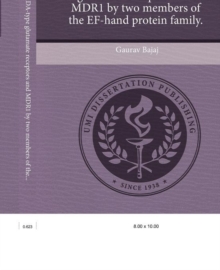Myosin RLC is an EF-hand protein that is traditionally considered an integral component of the myosin II complex.
We show that this light chain is important for trafficking of NMDA receptors and that this function is likely independent of the myosin II complex.
In addition, we studied the interaction of myosin RLC with a second non-myosin target, multi-drug resistance protein 1 (MDR1) also known as P-glycoprotein.
Finally, we characterized a previously undescribed calcium-dependent calmodulin binding site on the NMDAR 2A (NR2A) subunit of the NMDA receptor.
Calmodulin is structurally-related to myosin RLC and also considered an EF-hand protein.
In this study, we mapped the myosin RLC binding site to a 30-37 amino acid region of the C-termini of NR1 and NR2 subunits.
Myosin RLC-NMDA receptor subunit interactions could be distinguished from the prototypical interaction of myosin RLC with the neck region of non-muscle myosin II-B heavy chain.
NMDA-myosin RLC interactions were maintained in the absence of the fourth EF-hand domain and did not require the addition of magnesium.
We report that sequence similarity in the "GxxxR" portion of the incomplete IQ2 motif found in nonmuscle myosin II heavy chain isoforms likely contributes to the recognition of NR2A as a non-myosin target of the myosin RLC.
We report that myosin RLC-NR2A interactions likely occur in the Golgi complex and this interaction is important in forward trafficking of NR1/NR2A receptors.
We suggest that a role for myosin RLC in protein trafficking in polarized cells is distinct from the typical interaction of myosin RLC as a component of the myosin II complex.
Like glutamate receptor subunits, MDR1 is also a membrane-bound protein expressed in polarized cells.
MDR1 is a drug efflux transporter that consists of two homologous halves, each consisting of six membrane-spanning domains plus a nucleotide binding domain linked by an intracellular linker region.
The linker region of MDR1 is a determinant of cell surface expression and directly interacts with intracellular cytoskeletal, regulatory, and motor proteins.
A previous study documented a direct interaction between myosin RLC and the linker region of a related ABC transporter, bile salt export protein (BSEP), and established a role for myosin in BSEP trafficking.
We found that myosin RLC interacts with MDR1 via the amino terminal of the light chain as observed with NMDA receptor subunits.
This interaction of myosin RLC with both of its binding partners (MDR1 and NMDA receptor subunits) is decreased upon phosphorylation of specific residues in the amino terminal of the light chain.
We used Madin-Darby canine kidney (MDCK) cells stably expressing MDR1 (MDCKII-MDR1) as a model system to study the functional consequences of perturbing the phosphorylation state of myosin RLC in intact cells.
Treatment of polarized MDCKII-MDR1 monolayers with ML-7, a pharmacologic inhibitor of myosin light chain kinase, increased the permeability of [3H]-digoxin (a well-known substrate of MDR1) and decreased apical expression of MDR1 in MDCKII-MDR1 cells.
The combination of NR1 splice variants and NR2 subunits imparts differing physiological and pharmacological properties on NMDA receptor assemblies.
The NR2 C-termini of NMDA receptors are approximately 600 amino acids long and the middle region of NR2A C-terminus (NR2A (875-1029)) bears only 29% sequence similarity with the corresponding region in the NR2B subunit.
We used a proteomics approach to uncover proteins that may interact with this region from mouse brain homogenates both in the presence and absence of calcium.
Calmodulin was found to interact with NR2A (875-1029) in a...

